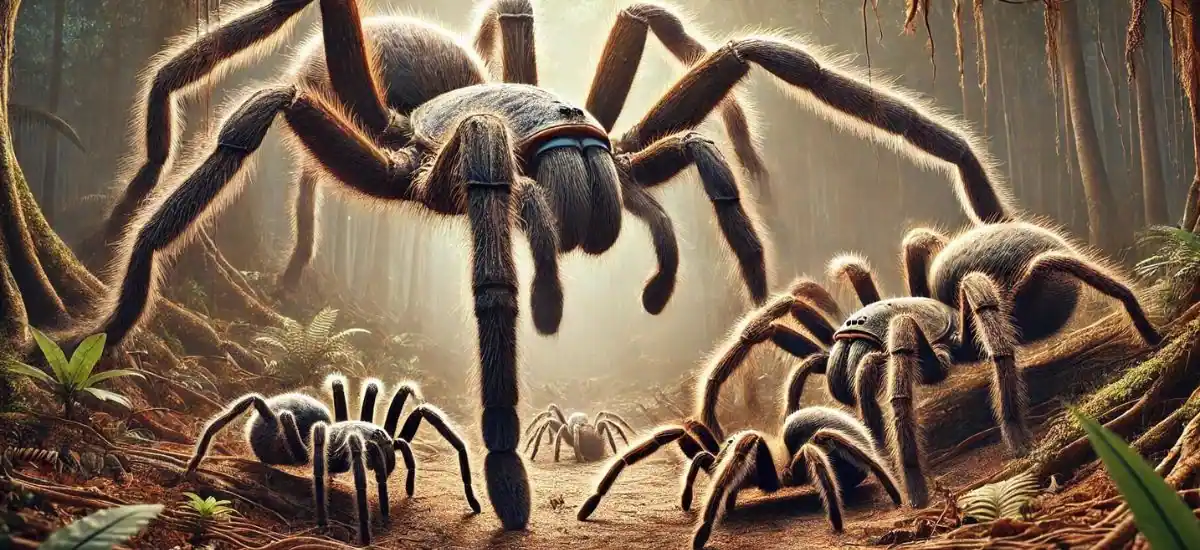Spiders—often the subject of both intrigue and alarm—occupy a diverse array of habitats around the globe. From the dark corners of our homes to the depths of rainforests, these creatures command attention. But it’s the giants among them that truly captivate our imagination. These are not your average backyard spiders; these are the behemoths of the arachnid world, showcasing just how formidable nature can be. Understanding these titans offers more than just a glimpse into the extraordinary; it highlights the critical roles they play in maintaining the balance of our ecosystems.
Understanding Spider Size: What Makes a Spider ‘Big’?
When it comes to spiders, size can be a bit deceptive. Are we talking about leg span—the distance from the tip of one extended leg to the tip of the opposite leg—or body mass? Typically, when we refer to the “biggest” spiders, we’re talking about leg span, which gives a more dramatic impression of size and is the most visually striking aspect. This measurement is crucial not just for the wow factor but also for understanding the spider’s ecological role, as larger spiders can tackle larger prey.
Top 10 Largest Spiders by Leg Span

1. Goliath Birdeater (Theraphosa blondi)
- Leg Span: Up to 11 inches
- Habitat: Rainforests of South America
- Features: This tarantula is not only the largest spider by mass but also among the heaviest. Despite its name, it seldom eats birds. It primarily feeds on insects and small vertebrates. This spider’s size is complemented by its formidable fangs, which can be over an inch long.
2. Giant Huntsman Spider (Heteropoda maxima)
- Leg Span: Up to 12 inches
- Habitat: Caves in Laos
- Features: Known for its incredible leg span, this spider holds the record for the largest leg span among all spiders. It’s remarkably speedy and agile, which helps it hunt prey effectively.
3. Brazilian Salmon Pink Birdeater (Lasiodora parahybana)
- Leg Span: Up to 10 inches
- Habitat: Rainforests of Brazil
- Features: This tarantula is known for its striking salmon-pink hair. It’s one of the most popular pets among spider enthusiasts due to its size and relatively docile nature.
4. Camel Spider (Solifugae)
- Leg Span: Up to 6 inches
- Habitat: Deserts around the world
- Features: Though not a true spider, this arachnid is frequently mistaken for one due to its size and appearance. Known for its formidable jaws, the camel spider is a fierce predator and can move at high speeds.
5. Colombian Giant Tarantula (Megaphobema robustum)
- Leg Span: Up to 8 inches
- Habitat: Rainforests of Colombia
- Features: This tarantula is robust and heavily built, known for its deep burrowing and aggressive temperament. It has a striking appearance with a dark body and reddish hairs.
6. Hercules Baboon Spider (Hysterocrates hercules)
- Leg Span: Up to 8 inches
- Habitat: West Africa
- Features: One of the rarest spiders, this baboon spider is seldom seen in the wild or in captivity. It is known for its aggressive nature and impressive size.
7. Brazilian Giant Tawny Red Tarantula (Grammostola iheringi)
- Leg Span: Up to 7 inches
- Habitat: Forests of Brazil and Uruguay
- Features: This spider is appreciated for its size and relatively calm demeanor, making it another favorite among pet owners. It has a tawny, reddish-brown color that adds to its visual appeal.
8. Golden Silk Orb-Weaver (Nephila)
- Leg Span: Up to 6 inches
- Habitat: Warmer regions worldwide
- Features: Famous for spinning large webs of golden silk, this spider’s web is strong enough to trap small birds, which are occasionally prey. The females are significantly larger than the males.
9. Brazilian Whiteknee Tarantula (Acanthoscurria geniculata)
- Leg Span: Up to 8 inches
- Habitat: Forests of Brazil
- Features: Known for its striking black and white banded legs, this spider is a popular choice in the pet trade. It is known for its bold behavior and hearty appetite.
10. Greenbottle Blue Tarantula (Chromatopelma cyaneopubescens)
- Leg Span: Up to 6 inches
- Habitat: Venezuela
- Features: This tarantula is renowned for its vibrant coloration, featuring a metallic blue body and a greenish carapace. It is an active webber, creating elaborate silk structures in its enclosure.
Record Holders: Heaviest Spiders in the World
While leg span gives us an idea of how large a spider looks, body mass tells us how hefty they really are. Here’s a closer look at some of the heaviest spiders known to science, showcasing that size isn’t just about length but also about weight.
- Goliath Birdeater (Theraphosa blondi): Not only does it hold records for leg span, but it’s also the heaviest spider in the world, weighing up to 6 ounces (170 grams). Its robust body and significant muscle mass make it a true heavyweight.
- Brazilian Salmon Pink Birdeater (Lasiodora parahybana): This species is not far behind, with adult females weighing approximately 3.5 ounces (100 grams). Their substantial size allows them to tackle impressively large prey.
- Columbian Giant Tarantula (Megaphobema robustum): Known for its girth, this spider combines a large leg span with a hefty body, weighing in at around 3 ounces (85 grams).
These spiders are not just large; they are literal giants of their domain, each with a mass that allows them to dominate their habitats and manage their ecological roles effectively.
Giant Spider Encounters: Human Interaction

When Humans and Giants Meet
Encounters with these gargantuan spiders can be startling, thrilling, or downright terrifying, depending on whom you ask. Here are a few notable interactions between humans and the world’s largest spiders:
- Photographic Ventures: Wildlife photographers often seek out these spiders as subjects, leading to breathtaking yet spine-chilling close-ups that highlight the intricate beauty of these creatures.
- Pet Trade: Many of the largest spiders are popular in the exotic pet trade. Owners report a range of behaviors from docile to aggressive, providing a unique insight into the care of such large arachnids.
- Scientific Studies: Researchers studying these spiders sometimes have the daunting task of handling them to measure, tag, or observe their behavior, contributing valuable data to our understanding of their biology and ecology.
These interactions underscore the complex relationship between humans and the largest spiders on Earth, highlighting both our fascination and our fears.
Conservation Status of the World’s Largest Spiders
Protecting Our Planetary Giants
Despite their formidable appearances, many of the world’s largest spiders face threats from habitat destruction, pollution, and the illegal pet trade. Here’s what is being done to protect them:
- Habitat Conservation: Efforts to preserve the natural habitats of these spiders are crucial. Protecting rainforests, deserts, and other natural areas helps maintain the biodiversity necessary for their survival.
- Legal Protections: Some species are protected under local or international laws that regulate or prohibit their trade to prevent overharvesting and ensure their populations remain stable.
- Educational Outreach: Increasing public awareness about the ecological roles of these spiders can reduce unfounded fears and promote conservation efforts. Educational programs that discuss the importance of spiders in controlling insect populations and maintaining healthy ecosystems are vital.
Myths vs. Reality: Debunking Common Misconceptions
Large spiders often fall victim to myths and misconceptions that exaggerate their danger to humans and other animals. Here’s the truth behind some of the most common myths:
- Myth: Large spiders are deadly to humans.
- Reality: Despite their intimidating size, none of the world’s largest spiders are lethal to humans. Most large spider species possess venom that is effective against their prey but only causes mild to moderate reactions in humans, similar to a bee sting.
- Myth: Giant spiders aggressively attack humans.
- Reality: Large spiders are generally reclusive and avoid humans. Most reported “attacks” are defensive actions when the spider is provoked or startled.
- Myth: Spiders of this size can consume larger animals.
- Reality: While some large spiders, like the Goliath Birdeater, can eat small birds and mammals, these are opportunistic feedings and not the norm. Their usual diet consists primarily of insects and occasionally small vertebrates.
Addressing these misconceptions is crucial for fostering a better understanding and respect for these remarkable creatures, reducing undue fear, and promoting coexistence.
Frequently Asked Questions
Q1. What do giant spiders eat?
Ans: Giant spiders mainly consume insects, though some species may occasionally eat small birds, lizards, or rodents depending on their environment.
Q2. How long do giant spiders live?
Ans: The lifespan varies significantly among species, but many large tarantulas can live for up to 15-20 years, especially in captivity where they are safe from predators.
Q3. Are these giant spiders endangered?
Ans: Some species are indeed considered at risk due to habitat loss and the illegal pet trade. Conservation efforts are essential to protect them.
Q4. Can I keep a giant spider as a pet?
Ans: Yes, several large spider species are kept as pets. However, potential owners should be aware of the care requirements and longevity of these creatures.
Conclusion
The world’s largest spiders are more than just fodder for scary stories; they are fascinating examples of nature’s ingenuity and play vital roles in their ecosystems. By understanding and respecting these creatures, we can appreciate their true nature and the importance of their survival. Let’s move beyond fear and appreciate these remarkable arachnids for the wonders they truly are.


